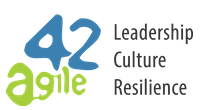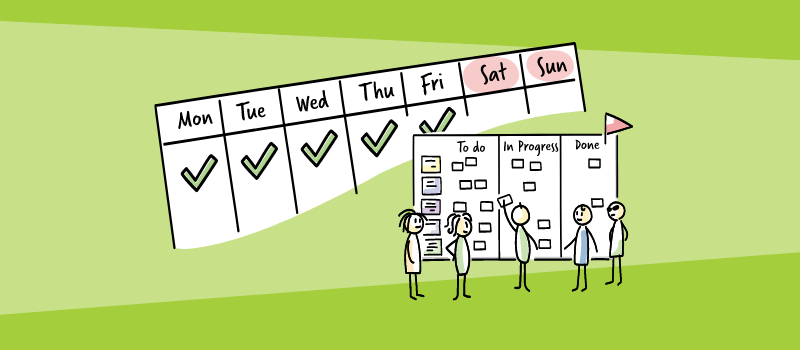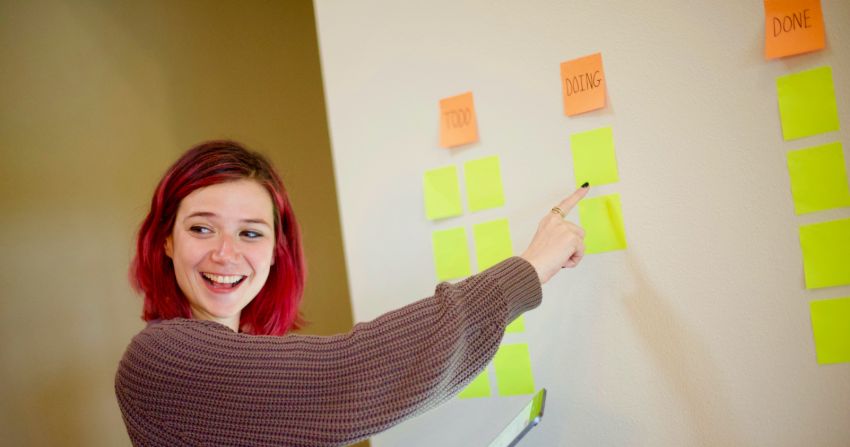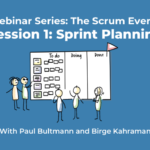How to Revive Your Daily Standup
The daily standup is a fundamental part of Scrum rituals, but it’s also one of the most misunderstood. At agile42, we’ve been coaching organizations to facilitate these Scrum events for 15 years. We’ve guided hundreds of teams towards making these 15-minute sessions stand out as a useful, valuable, and enjoyable event. Here’s our guide to what a daily standup actually is, along with some of our tried-and-tested methods to bring life back into the daily standup.
Recommended online course: Facilitating Scrum
What is a daily standup?
The daily standup is a 15-minute meeting that takes place every day. Although the meeting is not exclusive to Agile methods, it’s an integral part of many Agile frameworks and methods including Scrum, Kanban and XP.
Daily standup vs Daily Scrum
While the terms “daily standup” and “Daily Scrum” are used interchangeably, there is technically a difference. The Daily Scrum is how it is referred to in the Official Scrum Guide and makes up one of the five Scrum events. The daily standup is a more general term for a quick 15-minute catchup, used in Kanban and other settings outside of a Sprint.
Why is a daily standup meeting important?
It is important to understand the purpose of the daily standup, so that you can make sure this Scrum event is a good use of everyone’s time. The two key purposes of a Daily Standup are:
- to agree as a team on how to deliver the most value in the next working day; and
- to inspect and adapt the sprint plan if necessary, in order to deliver the most value in the sprint.
If you’re having trouble keeping your daily standups, it also helps to remember the Lean and Agile principles that guide these events:
- Focus on outcomes over output (or results over activity)
- Focus on priorities
- Emphasize team ownership of results over individual assignments

Photo by Parabol
How to run a daily standup
The standard format for a daily standup consists of each team member answering three questions:
- What did you achieve yesterday?
- What will you achieve today?
- What impediments are in your way?
This format is used widely with varying degrees of success. While it is the original, traditional format, you don’t have to use it if it doesn’t work for your team. Each team has its own needs and preferences, and as long as you’re focusing on what’s important – like communicating, prioritizing, and managing the flow (not the people) – you can change the format to better suit your needs. The traditional three-question format can also really easily devolve into a mere status update meeting, failing to achieve the purpose of the daily standup and failing to embody its principles. If that’s happened to your dailies, you may need to find a way to revive your standup.
How to revive your daily standup
If your daily standups have turned into status updates, your team is disengaged, and you’ve lost touch with the principles of Scrum that guide the concept of these meetings, you’re not alone. Many organizations have difficulty running effective standups, and their teams feel like they’re not an effective use of their valuable time. If the team is not finding the meeting useful, you need to find the root cause and fix it. Here are 10 ways you can bring life back into your daily standups, and reap the benefit of this crucial Scum event.
Think of it like a sports huddle
Jeff Sutherland, one of the creators of Scrum, says “The idea is for the team to quickly confer on how to move toward victory—i.e., complete the Sprint.” It may help to think of it like a huddle before a sports game: the team comes together to re-energise, encourage, and strategies for the day. It’s not a chance to chat about training schedules, travel expenses, discuss goals for the year, introduce new players, or any of the other concerns a team might have. It’s a quick, razor-focused strategy session for the match they are currently playing.

Photo by LOGAN WEAVER on Unsplash
Ask the right questions
If your daily standups are not working well for your team, and don’t feel like a good use of their time, it’s important to discover the root cause of this. Get someone from the team to observe the meeting and think about the following questions, to guide them to the cause of the concern:
- Situation: Does the team report to itself or the ScrumMaster? Is the situation presented honestly? Do they have facts and information in front of their noses? Is the granularity right?
- Focus: Is the goal clear? Is the team focusing on getting the next backlog item done, rather than ensuring everyone has work for the day? Is there a lot of bureaucratic overhead?
- Speaking: Does everyone get the opportunity to speak? Who speaks most, who is most silent? Do people listen intently or are they just waiting for their own turn? Are people supporting each other?
- Decision-making: Who makes decisions? Is it one person or the whole team? Do they evaluate multiple options? Are decisions based on facts? If they make guesses, do they go on to validate the decisions before investing time?
- Language: Does the team have their own “slang”? Does the body language support the verbal message? If you’re running virtual standups, are cameras on or off?
- Trust: Are they showing respect for each other and for other teams? Are they having fun together? Can they bring up difficult topics? Are they showing courage?
Focus on the work, not the individuals
The focus of a daily standup should be on stories and priorities, not on any individual’s to-do list or performance. Since you’re talking about the work and flow itself, and not about individuals, it is possible that one team member may speak a few times while others may speak less (or not at all) some days. This is okay: it is not a status report or a chance to check up on productivity; it is a chance for the team to make sure they have everything they need to achieve the outcomes they have in mind for that day.
Brush up on your Scrum foundational knowledge
You simply can’t facilitate a standup well if you aren’t well-versed in the principles of Scrum. Consider taking an online Scrum course, to make sure you are being guided by the right principles and practices.
Keep it to 15 minutes
The 15-minute time limit of a daily standup is there for a reason. Set a timer, and make sure you stick to it. This keeps the meetings productive, focused, and to-the-point. If other distracting conversations come up during this meeting, you can make a note of them, but do not discuss them now. Which brings us to our next point…
Use a parking lot to stay focused
Use a “parking lot” for discussions that are too long or do not concern the whole team. You can have a literal whiteboard in the office, or a virtual space like Miro or Trello. When the standup veers off course, and other topics emerge, simply note them down for later and move on. Remember that anyone has the right to call “timeout” on distracting conversations; this is not the job of a leader or Scrum Master.
Make sure these conversations and concerns don’t get forgotten forever. You can stick around after the standup to continue talking about them, or perhaps set aside a few minutes in your Retrospective at the end of the Sprint or project to do so. You can use a voting system to determine which parking lot conversations to prioritize and analyze. Keep the stand-up focused, finish it on time, and then anyone who needs to continue the parked discussions can do so after the meeting is over.
Agree on the Scrum Master’s role
It is not essential that the Scrum Master attends this meeting, but it is also allowed, if that works for the team. However, it is crucial that the daily scrum is for team members to connect, prioritize, and plan for the day. The team should be speaking and making eye contact with each other, rather than the Scrum Master (or any single individual). This is a good way to tell if there’s a problem in the way the standups are running.
Agree on the Scrum Master’s role, and what works for your team. Should they attend? If so, should their key focus be to ensure that everyone remains focused and no external people are disrupting the purpose of the meeting? Or perhaps they should simply observe, or be available in case they are needed to help with any particular impediments.
Change up the format
The traditional three-question format might work nicely for you, and that’s fine. But there are a number of other tried-and-tested formats that we’ve used at agile42 that can boost the effectiveness of the standup, depending on the team. Here are a few examples, suggested by some prominent thought leaders in the Agile community.
Walk The Board
Jason Yip, Senior Agile Coach for Spotify, uses the “Walk The Board” format for standups. It is a great way to keep the focus on the board. Here’s how the format works:
- Gather around your team’s board.
- Start with the highest priority story/feature in progress.
- Ask what we, as a team, can do to get that story done (per our Definition of Done).
- Ask what is blocking us, as a team, from getting the story done.
- Repeat steps 3-4 for the next few priority items, up to your team’s WIP limit.
- To finish, validate that everyone on the team has been heard and all are focused on the top priority stories.
The Sprint Goal
Olaf Lewitz, veteran and leader in the Agile community, suggests using a slightly different set of three questions: one that shifts the focus to the team and the sprint goal, rather than each individual’s list. He suggests asking:
- What did we (as a team) achieve to get closer to the sprint goal?
- What’s blocking us from focusing on the sprint goal?
- What do we agree on doing today to make sure we reach the sprint goal?
The Two Plus One Questions
Founder of agile42, Andrea Tomasini, starts his standups by asking each person the first two questions:
- What have I achieved since last time?
- What impediments are still in my way?
Based on these answers the team as a whole can devise the best plan for the day. Finally, each individual can clarify her/his commitment to the team’s plan for the day by answering the third question: What do I commit to achieving today?
The Story of the Day
Dave Sharrock proposes a single question, to ensure the team remains razor-focused on the sprint itself. The question is, simply, “Which story will we finish today?”
Use a ball to add dynamism
If you’re finding your main concern with standups to be that there is low energy and engagement, and you’re sure that you’re using the right format and sticking to the time limit, you can try adding a ball to the mix. Use a stress ball, tennis ball, or really anything you can throw around your workspace (without breaking things).
Once each person finishes speaking, they can throw the ball to the next person to indicate that it is their turn. This can make things a little more lively and fun, and it has the added benefit of keeping people listening and paying attention, since the structure is a little more unpredictable than going in a circle. If your team works remotely, you can use a version of this technique relatively easily. Simply say who you are passing the ball to, and that person can use your video conferencing tool’s “Raise Hand” feature to indicate that you’ve “caught the ball”. As an added bonus, nobody needs to know how good (or bad) your real-life catching and throwing skills are.
Check the granularity of your tasks
If you’re finding that your daily standup often runs over the time limit, and they’re defined by impediments, high levels of stress, or not meeting daily goals, there might be a problem with the granularity of your tasks in the first place. The tasks set each day should be achievable in a single day, to match the frequency of the meeting and foster collaboration rather than any kind of competition.
agile42 offers remote Scrum training
We offer Certified Scrum Master (CSM), Advanced Certified Scrum Master (A-CSM), Certified Scrum Professional-ScrumMaster (CSP-SM), Certified Scrum Product Owner (CSPO), Advanced Certified Scrum Product Owner (A-CSPO), and Certified Scrum Developer (CSD) training, in live remote sessions with our experienced certified coaches. If you need help, coaching, mentoring, or training, don’t hesitate to reach out!








